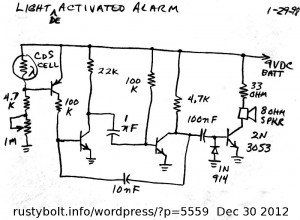 This light deactivated alarm (or should it be called a dark activated alarm?) might be used as a detector when a light beam is broken. I would use a red LED and restrict the light to a narrow beam so that it would be hard to see. When the CdS cell is illuminated and the circuit is deactivated the current drawn is only a few tens of microamps depending on where the 1 meg pot is set.
This light deactivated alarm (or should it be called a dark activated alarm?) might be used as a detector when a light beam is broken. I would use a red LED and restrict the light to a narrow beam so that it would be hard to see. When the CdS cell is illuminated and the circuit is deactivated the current drawn is only a few tens of microamps depending on where the 1 meg pot is set.
The two middle transistors are basically an astable multivibrator, with the 100k base bias resistor of the left transistor going to the collector of the PNP transistor, which acts as a switch to turn it on when the photocell is unlit. The right transistor is driven through the 100nF and directly drives the 9 ohm speaker. This transistor has no base bisa; it is running as a switch so it should not get hot. The 33 ohm resistor in series with the speaker limits the current through the speaker so that it doesn’t sound too loud and so it doesn’t overheat.
I once built a similar circuit using a small 1.5 inch speaker rated at about 0.2 watts. After a short time, the speaker voice coil went open, probably from excessive current and temperature. So if you decide to leave out the 33 ohm resistor, you should consider using a speaker capable of handling much more than 0.2 watts. Also, the 2N3053 is expensive and not easily obtained. I would suggest using a BD135 and small heatsink if it gets hot.